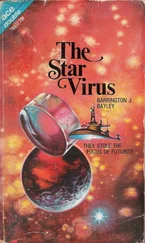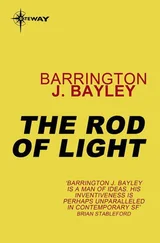Barrington Bayley - The Seed of Evil
Здесь есть возможность читать онлайн «Barrington Bayley - The Seed of Evil» весь текст электронной книги совершенно бесплатно (целиком полную версию без сокращений). В некоторых случаях можно слушать аудио, скачать через торрент в формате fb2 и присутствует краткое содержание. Город: London, Год выпуска: 2012, ISBN: 2012, Издательство: Gateway, Жанр: Фантастика и фэнтези, на английском языке. Описание произведения, (предисловие) а так же отзывы посетителей доступны на портале библиотеки ЛибКат.
- Название:The Seed of Evil
- Автор:
- Издательство:Gateway
- Жанр:
- Год:2012
- Город:London
- ISBN:978-0-575-10220-0
- Рейтинг книги:4 / 5. Голосов: 1
-
Избранное:Добавить в избранное
- Отзывы:
-
Ваша оценка:
- 80
- 1
- 2
- 3
- 4
- 5
The Seed of Evil: краткое содержание, описание и аннотация
Предлагаем к чтению аннотацию, описание, краткое содержание или предисловие (зависит от того, что написал сам автор книги «The Seed of Evil»). Если вы не нашли необходимую информацию о книге — напишите в комментариях, мы постараемся отыскать её.
, here is a second collection of endlessly inventive stories by Barrington J. Bayley; dark fables resounding with sombre undertones—love used as a weapon, God assassinated by the ingenuity of man, the secret of death revealed, the inexplicable explained! Tales which will be pondered on, and remembered.
The Seed of Evil — читать онлайн бесплатно полную книгу (весь текст) целиком
Ниже представлен текст книги, разбитый по страницам. Система сохранения места последней прочитанной страницы, позволяет с удобством читать онлайн бесплатно книгу «The Seed of Evil», без необходимости каждый раз заново искать на чём Вы остановились. Поставьте закладку, и сможете в любой момент перейти на страницу, на которой закончили чтение.
Интервал:
Закладка:
“Let us put it to the others,” he said at length, and spoke into the communicator, calling an officers’ conference.
The control cabin was claustrophobic by the time six officers had crowded into it. The air inductors weren’t designed to accommodate this many, and after ten minutes I was gasping for breath.
In the pause before Joule spoke, I heard the steady hum of the now resting ship. “You will all know by now,” he began, “that we are unable to break surface. Ross has a proposal, which he will outline to you.” He gave me a nod.
“Ever since the subterrene ship became a possibility,” I said, “I have conceived the idea of journeying into the interior of the Earth, perhaps to the centre itself. During the building of the Interstice I took advantage of the polariser propulsor’s ability to move very large masses, and made tentative plans for such an expedition. The Interstice is considerably larger than her first design called for: she has a heavier power plant, more instrumentation and food and air recyclers to keep a full crew supplied for several years. I also installed a workshop, and refrigerating equipment to guard against overheating.”
There were some surprised expressions among the Navy men when I revealed this, but others, those officers from my own civilian team, already knew of it. I feared no recriminations. The civilised man never entirely ignores the pursuit of knowledge.
“The Interstice is still not fully fitted for the voyage I envisaged,” I told them, “but in my opinion she will suffice. Since we are cut off from America, I propose to emerge on another quadrant of the planet.”
Joule interrupted here. “One point to bear in mind, gentlemen. It is possible that the barrier we encountered is an artificial device. If this is so, then our nation is at war, and the enemy already knows about subterrene ships. In this case it is our duty to return as soon as possible, not to go wandering off following our own interests.”
“I confess,” I said, “that I am delighted to have this opportunity to fulfil my ambitions. But in any case, there is no other way to make the Interstice useful in battle, since the shortest route to any other land mass now lies in an approach to the world’s core.”
“May I ask a technical question?” an officer asked. “Already we are close to the level where the Earth’s crust gives way to the hotter mantle. Beyond that, the liquid core is even hotter. Can we stand up to these conditions?”
“The polariser field makes us impervious in theory to any degree of heat or density,” I answered, “but it gives no protection from gravity and magnetism. Gravity will first aid, then hinder us. But magnetism will also grow intense towards the centre, and we have already seen what that can do to the polarisers.”
There were shudders as I said this.
“To be honest,” I continued, “if we run into a phenomenon like the one we have just escaped, I don’t know what we shall do. But there is an ingenious device called a gauss shunt, which can control gradual increments of magnetism by means of meson currents. This will not take too long to build, and should be able to handle the steady rise of energy we may naturally expect.”
The officers thought about it in silence. Already the Interstice had gone deeper than any before, slipping through high-density rock by virtue of the fact that the respective atoms of ship, men and air were individually aligned in different directions in space. At that very moment the cabin, the walls, our very bodies, were filled with a solid mass of hot rock, made impalpable by a delicate balance.
It was nightmarish to the imagination. But these were sturdy men, the cream of our nation, and they were inspired by my enthusiasm and by Joule’s leadership. “Come on!” I urged. “Man has never been this way before. Let us make the adventure!”
“I favour Ross’s proposal,” Joule said. “Any further questions?”
There were none. And once Joule had announced his decision, there were no objections.
“Ross will instruct you concerning the preparations for the deep dive,” he continued briefly. “That is all.”
For three days the Interstice poised her giant bulk ten miles down, while we worked on the gauss shunt. With our resources it did not prove difficult. We constructed a meson charger next to the ship’s power plant, and laid a skeleton of iron-silver channels over the inner hull, converging on a bank at the stern where the external magnetic fields could be passed back to ground. But for this, the polariser would be twisted out of alignment, and every scrap of metal would be melted by induction.
I used a rheostat control to test the shunt’s power to vary the magnetic field strength within the ship; then we were ready to reactivate the propulsors and turn our sluggish gravitational settling into a true power-dive.
The interior of the Interstice looked a devil’s workshop. An image came to my mind of the old days before the world’s surface was fully mapped, and windships might spread sail before new oceans, and new lands. For us, there were no free winds, no light, no rolling waters. We had passed outside the bounds of ordinary existence, and must force our way into darkness, pressure, heat.
Obediently, the motors pushed us deeper into the Earth. In the harsh yellow light which was our only illumination, the technicians watched the changing rock formations as they showed on the screens, noting down readings from the instruments. The information for which geologists had longed for centuries was now being collected with ease.
Down we sank, with the ever-present thought of the world’s solidity and the audacity of the human intellect which had conceived the subterrene ship. There was a quiet murmur of activity in the large hall-like enclosure of the Interstice, when I next walked her length to inspect the various equipments. We had just clocked three hundred miles.
Then, without warning, there was a blamn, followed by a heavy grating noise, and a shivering in the air. I recognised it, with utter amazement. I had heard it before, in the Navy’s laboratories. It was nothing to do with the magnetic barrier we had encountered earlier.
It was the noise created by the collision of two polariser fields.
I ran through the long passageways to Command Section. In the ante-room to the control cabin, the detector crew was scanning the vicinity, and the obstruction was taking shape on the screens.
But there was more than just one field. I saw a whole panorama of them, an extended complex, full of shadowy delineations to north, south, east and west, piling up, forming groups and spacious areas. For a while, it was more than I could believe.
We had blundered into a subsurface city.
Though it sounds incredible, Nature also has learned how to make two material objects occupy the same space, and she has riddled the Earth with beings in this manner. The conurbation into which we had plunged was huge, stretching beyond detector range. The scanners tended to indicate a rather weak polarisation, and I would guess that the inhabitants, if their experience can be described in human terms, dwell in a medium like thick treacle. The Interstice must have fallen on them as a super-bright, supersolid monster of almost indestructible qualities.
I went into the control cabin, where Captain Joule was gaping at the same scene on his own monitor screens, and sat down. Joule did not bother to acknowledge me.
He flicked a communicator switch. “Power Section! Listen for my orders. And give me steerage.”
I heard the snick as the steerage of the Interstice was transferred from the propulsor room to the control console before Joule’s bucket seat. The Interstice had become lodged between the walls of a group of buildings, and his magnificent broad shoulders hunched in an attitude of fury over the steering wheel, sweat staring out from his skin, as he tried to extricate her and batter a way into deeper territory.
Читать дальшеИнтервал:
Закладка:
Похожие книги на «The Seed of Evil»
Представляем Вашему вниманию похожие книги на «The Seed of Evil» списком для выбора. Мы отобрали схожую по названию и смыслу литературу в надежде предоставить читателям больше вариантов отыскать новые, интересные, ещё непрочитанные произведения.
Обсуждение, отзывы о книге «The Seed of Evil» и просто собственные мнения читателей. Оставьте ваши комментарии, напишите, что Вы думаете о произведении, его смысле или главных героях. Укажите что конкретно понравилось, а что нет, и почему Вы так считаете.












